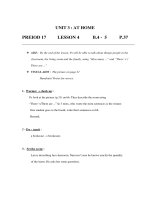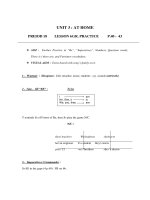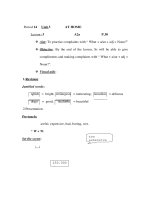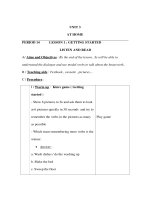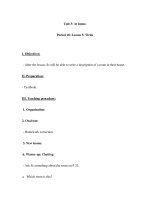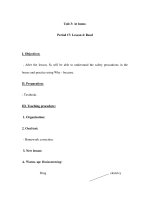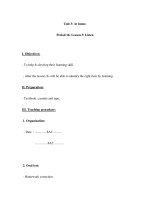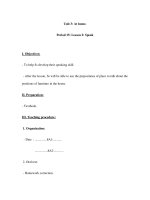Unit 3 At home
Bạn đang xem bản rút gọn của tài liệu. Xem và tải ngay bản đầy đủ của tài liệu tại đây (270.13 KB, 15 trang )
<span class='text_page_counter'>(1)</span>Preparing date: September 16, 2016.. Week:5 -Period: 13. UNIT 3 : AT HOME Section A1 : WHAT A LOVELY HOME! I. Aims - Knowledge: Students can describe the rooms and the house as well as make compliments. *Skills: Develop four skills. * Moral lesson: Ss shoud clean their funiture frequently. II. Language content 1.Vocabulary tub (n) stove (n) convenient (adj) dryer (n) washing machine (n) modern (adj) sink (n) awful (adj) bright (adj) dishwasher (n) amazing (adj) refrigerator (n) comfortable (adj) 2. Grammar What + (a/an) + adj + N(s)! III. Teaching aids 1. Documents for teaching: Book, teacher’s book… 2. Method: Communicative method. 3. Teaching tool: Lesson plan, book, pictures, cassette, tape. IV. Teaching steps 1. Class procedures * Greetings * Checking attendance Class Date Absent students Ss’ books 7A1 7A2 7A3 7A4 7A5 2. Cheking previous lesson (No) 3. New lesson Stages Warm up. Teacher and students’ activities T asks some questions about student’s house. Sts Answer Sts look at the picture and name some things in the house.. Presentation. T sets the situation, showing a picture of a house with different rooms, then have them point out the furniture in the room. Let Ss listen to the tape first time and presents new words.. Content * Questions: 1. How many rooms are there in your house? 2. Is it a big house or a small house? 3. Is it a lovely house / a beautiful house? 1. Listen. Then practice with a partner. 1.1 New words - awful (adj) - lovely (adj) - bright (adj).
<span class='text_page_counter'>(2)</span> Ss guess meaning of the words. T reads the new words and Ss repeat after the T. Ss repeat in chorus and individual.. Using “What and Where “to check new words.. Practice. Furtherpractice. - amazing (adj) - convenient (adj) - comfortable (adj) - bathroom (n) - sink (n) - tub (n) - shower (n) - washing machine (n) - dryer (n) - refrigerator (n) - dishwasher (n) - electric stove (n) - rest (n) - seat (n) * Check New Words : “ What and Where “. T gives a situation and present form. Ss copy down. - T : Is it a lovely house - Ss : Yes , it is - T: It is a lovely house. What a lovely house! 1.2 Grammar * Exclamations: Dung để diễn tả một cảm giác hay một xúc động. What + (a /an) + adj +N!. T writes guiding questions on the board and ask Ss to close their books Then, T leads Ss listen to the tape and answer the questions. Let Ss listen to the tape again and repeat in chorus. Ss repeat in chorus T asks Ss to practice the dialogue in pairs. Ss work in pairs. Call some pairs read the dialogue. Correct Let Ss practice in pairs: Ask and answer questions in the textbook. Ss do pair work Ask Ss write the answers on the board. Correct. * Guiding Questions a) How many rooms are there in Hoa’s house? b) Which rooms are there? c) Are they beautiful?. Ask Ss do pair work: Ask And answer about them.. About you: e) There are ……… rooms in my. * Practice with a partner. 1.3 Answer a) They talk about living room, Hoa’s (bed) room, and bathroom and kitchen room. b)Because it is bright and it has nice color: pink and white. c) A sink, a tub, and a shower. d)A washing machine, a dryer, a refrigerator, a dishwasher, and an electric stove.
<span class='text_page_counter'>(3)</span> Ss work in pairs house. Call some pairs of Ss practice in front f) There are ………………… in of the class. my room / kitchen / bathroom. 4. Homework and preparation Students read the dialogue part A1 again, learn by heart all new words and structures, prepare part A2, 3 for the next 5. Experience: ........................................................................................................................... .............................................................................................................................. Preparing date: September 16, 2016.. Week:5 -Period: 14. UNIT 3: AT HOME Section A2 : WHAT A LOVELY HOME ! I. Aims - Knowledge: Students have through grasp of exclamation sentences and describe a room with new structure. *Skills: Develop four skills. * Moral lesson: Ss should keep their houses clean and beautiful. II.Language content 1.Vocabulary: Boring (a); bad (a); delicious (a); interesting (a); wet (a); Expensive (a) # cheap (a) 2. Grammar:What + (a/an) + adj + N(s)! III. Teaching aids 1. Documents for teaching: Book, teacher’s book… 2. Method: Communicative method. 3. Teaching tool: Lesson plan, book, pictures. IV. Teaching steps 1. Class procedures * Greetings * Checking attendance Class Date Absent students Ss’ books 7A1 7A2 7A3 7A4 7A5 2. Cheking previous lesson (No) 3. New lesson Stages Teacher and students’ activities Content Warm up T asks sts to speak exclamation What a lovely dog ! sentences ->T corrects. What an interesting book! What a happy girl ! Presentation Last period, you have learnt 2.Write exclamations..
<span class='text_page_counter'>(4)</span> exclamation sentence, today you will practice it. T explains vocabulary Sts listen and repeat new words after T Get individual sts repeat new words on the board T corrects if necessary. Practice. Furtherpractice. 2.1 New words Boring(adj) bad(adj) delicious(adj) interesting(adj) wet(adj) Expensive(adj) # cheap(adj) 2.2 Grammar What + (a/an) + adj + N(s)! Ex :What a lovely cat! What an interesting film! What a happy boy! What interesting books!. T explains the structure T asks sts to make some exclamatory sentences T asks sts to write the complaints and compliments, using the phrases in the boxes. Sts do the exercises, one reads, one writes on the board. T asks sts to check their exercises in pairs. Sts practice.. a) Complaints 1.What a awful restaurant! 2. What a wet day! 3. What a boring party! 4. What a bad movie !. Have Ss read the sentences and write the exclamations. Ss do in 3 minutes and then go to the board and write their answers.. More exercise 1. The girl is beautiful. What a beautiful girl! 2. This is a very modern house. What a modern house! 3. The dolls are big. What big dolls! 4. He is a lazy student. What a lovely student!. T asks Ss to remind the structures.. b) Compliments 1. What a great party! 2. What a bright room! 3. What an interesting movie! 4. What a lovely house! 5. What a delicious dinner! 6. What a beautiful day!. 4.Homework and preparation Students do all exercise at home again and learn by heart the structures. Prepare part B 1 for the next period. 5.Experience: ........................................................................................................................... ..............................................................................................................................
<span class='text_page_counter'>(5)</span> Preparing date: September 16, 2016.. Week:5 -Period: 15. UNIT 3 : AT HOME Section B1, : HOA’S FAMILY I. Aims - Knowledge: Sts learn how to ask and answer a question about job *Skills: Develop four skills. *Moral lesson: Ss should help their parents after school. II. Language content 1. Vocabulary: Countryside (n); grow (v); raise (v); cattle (n); busy (a); hard (a); Housework (n); job (n); younger (a); only (a); 2. Grammar: What + do / does + S + do? What be +one’s job? S + to be + a/an + name of jobs III. Teaching aids 1. Documents for teaching: Book, teacher’s book… 2. Method: Communicative method. 3. Teaching tool: Lesson plan, book, pictures, cassette, tape. IV. Teaching steps 1. Class procedures * Greetings * Checking attendance Class Date Absent students Ss’ books 7A1 7A2 7A3 7A4 7A5 2. Cheking previous lesson T asks sts to write 5 exclamatory sentences What a beautiful girl! What naughty boys! What lovely animals! What a nice day! What an intelligent boy!.
<span class='text_page_counter'>(6)</span> 3. New lesson Stages Teacher and students’ activities Warm up Divide the class into two groups and asks a member of each group to write some jobs that Ss have learnt. Which group writes many words and writes right that group is winner.. Presentation. * Introduce the new lesson T gives some questions Ss listen and answer. T corrects Then , T uses picture B1 and gives questions. Ss listen and answer. T corrects. Let Ss listen to the tape first time. Ss listen and not repeat. T presents new words and explains them. Ss listen and copy down.. T hangs flip – chart on the board : “ True or False “. Practice. T leads Ss to listen to the tape and repeat in chorus. Ss repeat in chorus Then T asks Ss to do exercises. Ss do exercise. T corrects. T asks Ss to read the dialogue in pairs. Ss practice in pairs. Call some pairs read the dialogue again. Then, T asks Ss to answer questions in pairs. Ss answer them. Call Ss write the answers on the board. T corrects. Content Group A Group B jobs * Questions 1. How many people are there in your family? 2. What does your father / mother do? 3. What do they do? 1. Listen. Then practice with a parner. 1.1 New words countryside (n) cattle (n) housework (n) job (n) grow (v) raise (v) busy (adj) hard (adj) only (adj) 1.2 Grammar What + do / does + S + do? What be +one’s job? - S +to be + a/an + name of jobs 1.3 True or False 1. Hoa’s father is a farmer. 2. He works on farm in the city. 3. Her mother is a housewife. 4. Hoa has a younger brother. 5. He is only 8. Practice with a partner. 1.4 Answer the questions a. He’s a farmer. b. He works on his farm. c. She’s a housewife. She does housework and she helps on the form. d. Yes, they are. (Because they love working on their farm) e. She is 8..
<span class='text_page_counter'>(7)</span> Futherpractice. Ask Ss to practice in pairs Have ss practice in pairs, ask and answer about their own family. 4. Homework and preparation Students learn by heart new words and the dialogue about Hoa’s family prepare B2,3,4 for the next period. 5.Experience: ........................................................................................................................... ............................................................................................................................. Dak-o, September 18th, 2016. (check and sign). Preparing date: September 23, 2016.. Week:6 - Period: 16. UNIT 3 : AT HOME Section B 2,3, 4 : HOA’S FAMILY I. Aims - Knowledge: Students learn how to describe about jobs such as: doctor, journalist. * Skills: Develop four skills. * Moral lesson: Ss shoud study hard to have a good job in the future. II. Language content 1.Vocabulary: (v) : take care of = look after (n) : journalist , primary school (a) : sick = ill, elder 2.Grammar: What + do / does + S + do ? Where +do/does+ S + work ? III. Teaching aids 1. Documents for teaching: Book, teacher’s book… 2. Method: Communicative method. 3. Teaching tool: Lesson plan, book, pictures, cassette, tape. IV. Teaching steps 3. Class procedures * Greetings * Checking attendance Class Date Absent students Ss’ books 7A1 7A2 7A3 7A4 7A5 4. Cheking previous lesson (No) T asks students some questions: What does your father/mother do? How old is he/she? 3. New lesson Stages Warm up. Teacher and students’ activities - T gives some questions and Ss answer .. Content 1. How many people are there in your family ?.
<span class='text_page_counter'>(8)</span> Presentation. - Correct .. 2. What do your parents do ?. T leads to the new lesson Use pictures of B2 to explain new words . Ss listen and copy down . T reads the new words and Ss repeat in chorus after the T . Some ss read the new words individually. T correct.. 2. Read 2.1 New words sick=ill (a); elder (a); take care of=look after (v) primary school (n) journalist(n) 2.2 Grammar What + do / does + S + do ? Where +do/does+ S + work ?. T introduces the questions to ask about sb’s job and where he/she works. Practice. T reads the text. Ss listen and repeat after the teacher T asks Ss to answer guiding questions and Ss answer them. Correct. * Questions A. What does your mother do ? B. She’s a doctor A. Where does she work ? B. She works in the hospital. T calls some Ss read the text again Ss read it again. Correct. T leads Ss to practice in pairs: talk about Hoa’s family and Ss’ family themselves. Ss work in pairs. One asks, one answers the questions. Call Ss write the questions and answers on the board. Correct.. 2.3 Practice with a partner a)Talk about Lan’s family St1 : What does her father / mother / brother do? St2 : He is a doctor / She is a teacher / He is a journalist St1 : Where does her father / mother / brother do ? St2 : He works in a hospital / She works in a primary school / He writes for a Ha Noi newspaper. Sts practice freely about their families. T calls some ss to talk about their b)About you. family. Divide the class into two groups. Call a member of each group match column A with Column B. Which groups writes quick and right that groups is winner. Ss match column A with column B Correct. Ask Ss to tell information that they ought to listen to complete these forms. Ss tell the information.. 3. Match these half -sentences Group A Group B A farmer writes for a newsp A doctor works on a farm A journalist teaches in a school A teacher take care of sick people 4. Listen. Complete these forms 1. Name: Tom.
<span class='text_page_counter'>(9)</span> Production. Let Ss listen to the tape. Ss listen it. T writes new word and explains. Ss listen and copy down. T reads and Ss repeat after the T. Then, T aks Ss to practise in four groups. Ss do in four groups . T asks close their books and leads Ss to listen to the tape three times. Then, write exercises on the flipcharts. Ss listen the tape and write the exercises on the flipcharts. Call Ss hang the flipcharts on the board and correct.. Age: 26 Job: teacher Place of work: at a high school. 2. Name: Susan Age: 19 Job: journalist Place of work: for a magazine. 3. Name: Bill Age: 20 Job : nurse Place of work : in a hospital .. Ask Ss to practise in pairs: ask and answer about name, age, job, place of work themselves or their parents. Ss practice in pairs. One asks, one answer. T Corrects 4. Homework and preparation Students do all exercise at home again and learn by heart the structures prepare B 5,6 for the next period. 5. Experience ........................................................................................................................... .............................................................................................................................. Preparing date: September 23, 2016.. Week:6 - Period: 17. UNIT 3 : AT HOME Section B 5, : HOA’S FAMILY I. Aims - Knowledge: through the passage, students can consolidated the knowledge that they’ve been taught last period and practice the comparative, superlative fluently * Skills: Develop four skills. * Moral lesson: Ss shoud keep their house as well as their neighborhood clean. II. Language content 1.Vocabulary easy # difficult; find (v); empty (adj); expensive (adj) # cheap (adj); furnished(adj) 2. Grammar Comparative : S1+be+short adj+ER+than +S2+be/ O2 S1+be+more+long adj+than+ S2+be/ O2 Superlative : S+be+the short adj + EST… S + be + the most + long adj… III. Teaching aids 1. Documents for teaching: Book, teacher’s book….
<span class='text_page_counter'>(10)</span> 2. Method: Communicative method. 3. Teaching tool: Lesson plan, book, pictures, cassette, tape. IV. Teaching steps 1. Class procedures * Greetings * Checking attendance Class Date Absent students 7A1 7A2 7A3 7A4 7A5 2. Cheking previous lesson (No) Ask students to talk about their family member’s jobs 3. New lesson Stages Warm up. Presentation. Ss’ books. Teacher and students’ activities Have Ss name some rooms in their house. T gives some questions and Ss anwer them. T corrects.. Content 1/ How many rooms are there in your rooms? 2/ What rooms are there?. T presents new words. Explain the new words. Ss listen and not repeat. T reads the new words and Ss repeat in chorus. Copy down.. 5. Listen and read 5.1 New words - furnished (a): - suitable (a): - easy (a): - difficult (a) - find (v) - empty (adj) - expensive (adj) - cheap (adj);. T gives situations for review structures. Ss listen and answer teacher’s questions.. 5.2 Grammar Comparatives * Eg: This ruler is shorter than that ruler S1+ be +(short adj) er +than+O2 This book is more expensive than that book. S+be+ more + long adj + than + O2 . Superlative It is the cheapest bike. S + be( am / is / are ) + the + short adj + est + N … She is the most beautiful girl.
<span class='text_page_counter'>(11)</span> Practice. T gives guiding questions on the board. Then T asks Ss to close their books and listen to the tape twice. Ss listen to the tape and answer the questions. Listen and correct. Lead Ss to listen to the tape Ask Ss to practise in pairs: Read the dialogue. Ss do pairwork: St1: John & St2: Nhat Call some pairs read the dialogue. Ss read it. Correct. Ask Ss to answer the questions in pairs. Ss practice in pairs. Call Ss write the answers on the board. Correct.. Production. Call Ss to read the dialoguein pairs again and answer questions . Ss read it and answer the questions Correct. in our class. S + be( am / is / are ) + the most + long adj + N … * Listen and complete the table Apart ment at no. 27. Apart ment at no. 40. Apartment at no. 79. Bedroom Price Other descriptions. 5.3 Answer a. The one at number 27 is the cheapest apartment. b. The one at number 79 is the most expensive. c. The one at number 79 is the best apartment. d. The one at number 27 is the most suitable apartment for John and his family. The most suitable apartment is the smallest but it is the newest of three apartments. It has two bedrooms, a large, modern bathroom and a kitchen. Read the dialogue and answer the questions 1. How many rooms are there in the apartment at number 27? 2. Is it a lovely apartment?. 4. Homework and preparation Students do all exercise at home again and learn by heart the letter Prepare language focus 1 for the next period. 5. Experience ........................................................................................................................... ..............................................................................................................................
<span class='text_page_counter'>(12)</span> Preparing date: September 23, 2016.. Week:6 - Period: 18+ 19 LANGUAGE FOCUS 1. I. Aims - Knowledge: Through the period teacher helps students consolidate the knowledge that they’ve just studied at unit 1, 2, 3 and reminds students the new words. *Skills: Develop four skills. * Moral lesson: Ss shoud go to school on time. II. Language 1.Vocabulary: these vocabularies they have learnt last periods 2.Grammar: these structures they have learnt last periods III. Teaching aids 1. Documents for teaching: Book, teacher’s book… 2. Method: Communicative method. 3. Teaching tool: Lesson plan, book, pictures, cassette, tape. IV. Teaching steps 1. Class procedures * Greetings: Good afternoon class! * Checking attendance: Who’s absent today? How many? Class Date Absent students Ss’ books 7A1 7A2 7A3 7A4 7A5 Class 7A1 7A2 7A3 7A4 7A5. Date. Absent students. Ss’ books. 2. Cheking previous lesson (No) T shows the pictures and have students use the adjective to make comparison.. The first dress is more beautiful than the second one. The first dress is more expensive than the second one..
<span class='text_page_counter'>(13)</span> Xuka is the most industrious. I think Doraemon is the most intelligent. 3. New lesson Stages Teacher and students’ activities Warm up T asks Ss to ask and answer questions about themselves. Ss ask and answer the questions. T corrects T gives some questions and Ss answer them. T corrects. Presentation. Practice. Presentation. Practice. Presentation Practice. T asks Ss to look at the board and review the structure again Ss give structure, T writes them on the board and Ss copy down. T guides Ss how to do the exercises T asks Ss to complete the passage using the verbs in brackets.. Content. * Questions 1. What’s your name? 2. What do you do? 3. Where do you live ? 1. Present simple tense a. Tobe : S+ be (is/ am/are) + ....... b. Ordinary Verbs : S+ V(s/es) + ……….. *Complete the passage using the verbs in brackets a. is, live, are, goes b. are, eat, rides, catch. T gives questions and ask Ss to answer * Questions them 1) Will you be free tonight? Ss listen and answer. T corrects. 2) What will you do? T asks Ss to review the structure 2. Future simple tense Ss give structure, then T writes on the 1) Affirmative board. Ss copydown S +will/shall + V(inf) …… T corrects if necessary. 2) Negative S + will/shall + not + V(inf) Lead Ss to do exercises as example in 3) Interrogative text book. Will / Shall + S + V(inf) … ? Ss listen and do the exercises. Example Call Ss to write them on the board. a. Nam will do his homework Correct but he won’t tidy the yard . b. He will see a movie but he won’t watch TV T writes some cardinal numbers on the board and asks ss to write the ordinal numbers. Ss practice as T says.. Eg: 25, 46, 30 … 3. Ordinal numbers Group A.
<span class='text_page_counter'>(14)</span> Divide the class into two groups and call each member of two groups write ordinal Numbers and cardinal numbers Ss write as T says Correct. First (1), fourth (4), fifth (5), Sixth (6), third (3), second (2) Seventh (7) Group B 26: twenty - six 25: twenty - five. T asks Ss to name some prepositions that Ss have learnt.. 4. Prepositions On, at, in, behind, under, next to. Practice. Ask Ss to practise in pairs Ss do paiwork: ask and answer the question: Where’s my cat? Call Ss write the answers on the board. Correct.. St1: Where is my cat? St2: a. It’s under the table. b. It’s in front of the chair. c. It’s behind the TV. d. It’s next to the book case. e. It’s on the couch.. Presentation. T reads and writes somes examples in text books on the board (using picture ) T asks Ss to review the structure. Ss review the comparative and superlative structures. T writes the structures on the board. Presentation. Practice. Presentation. Practice. Call Ss go to the board and do exercise T corrects. T gives questions and Ss answer Correct Present new word and Ss listen Repeat in chorus after the teacher . Individual Ask Ss to work in pairs. Ss do pairwork. T corrects. 5. Adjectives Eg: A is a cheap toy. B is cheaper toy. B is cheaper than A. S1 + be + short adj +er + than +S2+be/ O2 S1 + be + more +long adj + than +S2+be/ O2 But C is the cheapest toy . S + be + the short adj + est S + be + the most + long adj b. A is expensive dress , And B is more expensive, But C is the most expensive. c. A is a good student, And B is better, However, C is the best. d. A is strong, And B is stronger, However, C is the strongest. * Questions 1) What do your parents do? 2) Where do they work? - Occupation (n) : 6. Occupations a) St1: What is his job? St2 : He is a fireman b) St1: What is her job? St2: She is a doctor c) St1: What is his job? St2: She is a teacher.
<span class='text_page_counter'>(15)</span> d) St1: What is his job? St2: He is a farmer Presentation. Practice. Production. T gives some questions. Ss listen and answer. T corrects T uses picture in textbook and leads Ss to do exercises in pairs. Ss do the exercises in pairs. T corrects.. T uses a flipchart and leads Ss to practice in pairs. Ss do pairwork. Call some pairs read in front of the class.. * Questions 1) Is there a door in your classroom? 2) Are there any windows in your classroom? 7. Is there a…? Are there any …? a) Are there any books? Yes, there are. b) Are there any armchairs? No, there aren’t. c) Is there a telephone? No, there isn’t. d) Are there any flowers? Yes , there are . 8. Questions words Eg : St1 : What is his name ? St2 : His name is Pham Trung Hung St1: What’s his age? St2: He is twenty. St1: What’s his address? St2: It’s 34 Nguyen Bieu street, Hai Phong. St1:What’s his job? St2: He is an Office Manager. 4. Homework and preparation Students learn all the structure and question words by heart Prepare test No.1 5. Experience .................................................................................................................................... .. ...................................................................................................................................... Dak-o, September 25th, 2016. (check and sign).
<span class='text_page_counter'>(16)</span>

